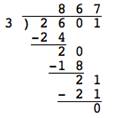
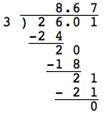
Multiplying and Dividing Decimals
As with whole numbers, sometimes you run into situations where you need to multiply or divide decimals. And just as there is a correct way to multiply and divide whole numbers, so, too, there is a correct way to multiply and divide decimals.
Imagine that a couple eats dinner at a Japanese steakhouse. The bill for the meal is `$58.32`—which includes a tax of `$4.64`. To calculate the tip, they can double the tax. So if they know how to multiply `$4.64` by `2`, the couple can figure out how much they should leave for the tip.
Here’s another problem. Andy just sold his van that averaged `20` miles per gallon of gasoline. He bought a new pickup truck and took it on a trip of `614.25` miles. He used `31.5` gallons of gas to make it that far. Did Andy get better gas mileage with the new truck?
Both of these problems can be solved by multiplying or dividing decimals. Here’s how to do it.
Multiplying decimals is the same as multiplying whole numbers except for the placement of the decimal point in the answer. When you multiply decimals, the decimal point is placed in the product The result when two numbers are multiplied. For example, the product of `4 * 5` is `20`. so that the number of decimal places in the product is the sum of the decimal places in the factors A number that is multiplied by another number or numbers to get a product. For example, in the equation `4 * 5 = 20`, `4` and `5` are factors. .
Let’s compare two multiplication problems that look similar: `214 * 36`, and `21.4 * 3.6`.
|
|
|
Notice how the digits in the two solutions are exactly the same: `7`, `7`, `0`, and `4`. The multiplication does not change at all. The difference lies in the placement of the decimal point in the final answers: `214 * 36 = 7,704`, and `21.4 * 3.6 = 77.04`.
To find out where to put the decimal point in a decimal multiplication problem, count the total number of decimal places in each of the factors.
`21.4` the first factor has one decimal place
`3.6` the second factor has one decimal place
`77.04` the product will have `1 + 1 = 2` decimal places
Note that the decimal points do not have to be aligned as for addition and subtraction.
|
Example |
|||
|
Problem |
`3.04*6.1=?` |
||
|
|
|
|
Set up the problem.
Multiply `3.04` by `6.1`.
Add `304` and `18240`.
|
|
|
|
Count the total number of decimal places in the factors and insert the decimal point in the product.
`2` decimal places in `3.04`. `1` decimal place in `6.1`.
`3` total decimal places. |
|
|
Answer |
`3.04 * 6.1 = 18.544` |
||
Sometimes you may need to insert zeros in front of the product so that you have the right number of decimal places. See the final answer in the example below:
|
Example |
|||
|
Problem |
`0.037*0.08=?` |
|
|
|
|
|
|
Set up the problem.
Multiply `0.037` by `0.08`. |
|
|
|
|
Count the total number of decimal places in the factors and insert the decimal point in the product.
`3` decimal places in `0.037`. `2` decimal places in `0.08`. `5` decimal places in the product. |
|
Answer |
`0.037 * 0.08 = 0.00296` |
Note that you needed to add zeros before `296` to get the `5` decimal places. |
|
If one or more zeros occur on the right in the product, they are not dropped until after the decimal point is inserted.
|
Example |
|||
|
Problem |
`2.04*1.95=?` |
|
|
|
|
|
|
Set up the problem.
Multiply `2.04` by `1.95`.
Add `1020, 18360, "and"\ 20400`. |
|
|
|
`2` decimal places in `2.04`. `2` decimal places `1.95`.
`4` decimal places.
|
|
|
Answer |
`2.04 * 1.95 = 3.978` |
Answer can omit the final trailing `0`. |
|
|
Multiplying Decimals
To multiply decimals:
|
|
Multiply. `51.2 * 3.08`
A) `15769.6`
B) `1576.96`
C) `157.696`
D) `15.7696`
|
Take a moment to multiply `4.469` by `10`. Now do `4.469 * 100`. Finally, do `4.469 * 1,000`. Notice any patterns in your products?
|
|
|
Notice that the products keep getting greater by one place value as the multiplier (`10`, `100`, and `1,000`) increases. In fact, the decimal point moves to the right by the same number of zeros in the power of ten multiplier.
| `4.469*10` | `=` | `44.69` | `4.469*100` | `=` | `446.9` | `4.469*1,000` | `=` | `4469.` |
You can use this observation to help you quickly multiply any decimal by a power of ten (`10`, `100`, `1,000`, etc).
|
Example |
|||
|
Problem |
`0.03*100=?` |
|
|
|
|
`0.03 * 100 =?` |
|
`100` has two zeros. |
|
|
`0.03 * 100 = 3` |
|
Move the decimal point two places to the right to find the product. |
|
Answer |
`0.03 * 100 = 3` |
|
|
|
Multiplying a Decimal by a Power of Ten
To multiply a decimal number by a power of ten (such as `10`, `100`, `1,000`, etc.), count the number of zeros in the power of ten. Then move the decimal point that number of places to the right.
For example, `0.054 * 100 = 5.4`. The multiplier `100` has two zeros, so you move the decimal point in `0.054` two places to the right—for a product of `5.4`.
|
To divide decimals, you will once again apply the methods you use for dividing whole numbers. Look at the two problems below. How are the methods similar?


Notice that the division occurs in the same way—the only difference is the placement of the decimal point in the quotient The result of a division problem. In the problem `8` ÷ `2 = 4`, `4` is the quotient. .
|
Example |
|||
|
Problem |
`18.32-:8=?` |
|
|
|
|
|
|
Set up the problem. |
|
|
|
|
Divide. |
|
|
|
|
Place the decimal point in the quotient. It should be placed directly above the decimal point in the dividend. |
|
Answer |
`18.32-:8 = 2.29` |
|
|
But what about a case where you are dividing by a decimal, as in the problem below?

In cases like this, you can use powers of `10` to help create an easier problem to solve. In this case, you can multiply the divisor The number that is being divided into the dividend in a division problem. In the problem `8` ÷ `2 = 4`, `2` is the divisor. , `0.3`, by `10` to move the decimal point `1` place to the right. If you multiply the divisor by `10`, then you also have to multiply the dividend The number to be divided up in a division problem. In the problem `8` ÷ `2 = 4`, `8` is the dividend. by `10` to keep the quotient the same. The new problem, with its solution, is shown below.
|
Example |
|||
|
Problem |
`260.1-:0.3=?` |
|
|
|
|
|
|
Set up the problem. |
|
|
|
|
Multiply divisor and dividend by `10` to create a whole number divisor. |
|
|
|
|
Divide. |
|
Answer |
`260.1-:0.3 = 867` |
|
|
Often, the dividend will still be a decimal after multiplying by a power of `10`. In this case, the placement of the decimal point must align with the decimal point in the dividend.
|
Example |
|||
|
Problem |
`15.275-:3.25=?` |
|
|
|
|
|
|
Set up the problem. |
|
|
|
|
Multiply divisor and dividend by `100` to create a whole number divisor. |
|
|
|
|
Divide. `325` goes into `1527` four times, so the number `4` is placed above the digit `7`.
The decimal point in the quotient is placed directly above the decimal point in the dividend. |
|
Answer |
`15.275-:3.25 = 4.7` |
|
|
|
Dividing Decimals
Dividing Decimals by Whole Numbers Divide as you would with whole numbers. Then place the decimal point in the quotient directly above the decimal point in the dividend. Dividing by Decimals To divide by a decimal, multiply the divisor by a power of ten to make the divisor a whole number. Then multiply the dividend by the same power of ten. You can think of this as moving the decimal point in the dividend the same number of places to the right as you move the decimal point in the divisor.
Then place the decimal point in the quotient directly over the decimal point in the dividend. Finally, divide as you would with whole numbers.
|
|
Divide: `25.095-:0.5.`
A) `5,019`
B) `501.9`
C) `50.19`
D) `0.5019`
|
Recall that when you multiply a decimal by a power of ten (`10`, `100`, `1,000`, etc.), the placement of the decimal point in the product will move to the right according to the number of zeros in the power of ten. For instance, `4.12 * 10 = 41.2`.
Multiplication and division are inverse operations, so you can expect that if you divide a decimal by a power of ten, the decimal point in the quotient will also correspond to the number of zeros in the power of ten. The difference is that the decimal point moves to the right when you multiply; it moves to the left when you divide.
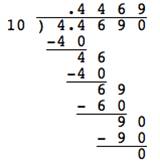
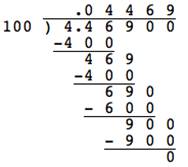
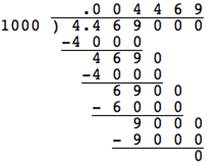
In the examples above, notice that each quotient still contains the digits `4469`—but as another `0` is added to the end of each power of ten in the divisor, the decimal point moves an additional place to the left in the quotient.
|
Dividing by Powers of Ten
To divide a decimal by a power of ten (`10`, `100`, `1,000`, etc.), count the number of zeros in the divisor. Then move the decimal point in the dividend that number of decimal places to the left; this will be your quotient.
|
|
Example |
|||
|
Problem |
`31.05-:10=?` |
|
|
|
|
`31.05-:10=?` |
|
`10` has one zero. |
|
|
`31.05-:10 = 3.105`
|
|
Move the decimal point one place to the left in the dividend; this is the quotient. |
|
Answer |
`31.05-:10 = 3.105` |
|
|
|
Divide. `0.045-:100`
A) `0.00045`
B) `0.045`
C) `4.5`
D) `4,500`
|
Now let’s return to the two problems from the beginning of this section. You know how to multiply and divide with decimals now. Let’s put that knowledge to the test.
|
Example |
|||
|
Problem
|
A couple eats dinner at a Japanese steakhouse. The bill for the meal totals `$58.32`—which includes a tax of `$4.64`. To calculate the tip, they can double the tax. How much tip should the couple leave? |
||
|
|
|
|
Set up a multiplication problem.
|
|
|
|
|
Multiply `4.64` by `2`. |
|
|
|
|
Count the number of decimal places in the two factors, and place the decimal point accordingly. |
|
Answer |
The couple should leave a tip of `$9.28`. |
|
|
|
Example |
|||
|
Problem
|
Andy just sold his van that averaged `20` miles per gallon of gasoline. He bought a new pickup truck and took it on a trip of `614.25` miles. He used `31.5` gallons of gas for the trip. Did Andy get better gas mileage with the new truck? |
||
|
|
|
|
Set up a division problem. |
|
|
|
|
Make the divisor a whole number by multiplying by `10`; do the same to the dividend. |
|
|
|
|
Divide. Insert a decimal point in the quotient so that it is directly above the decimal point in the dividend. |
|
Answer |
Andy gets `19.5` miles per gallon now. He used to get `20` miles per gallon. He does not get better gas mileage with the new truck. |
||
Learning to multiply and divide with decimals is an important skill. In both cases, you work with the decimals as you have worked with whole numbers, but you have to figure out where the decimal point goes. When multiplying decimals, the number of decimal places in the product is the sum of the decimal places in the factors. When dividing by decimals, move the decimal point in the dividend the same number of places to the right as you move the decimal point in the divisor. Then place the decimal point in the quotient above the decimal point in the dividend.